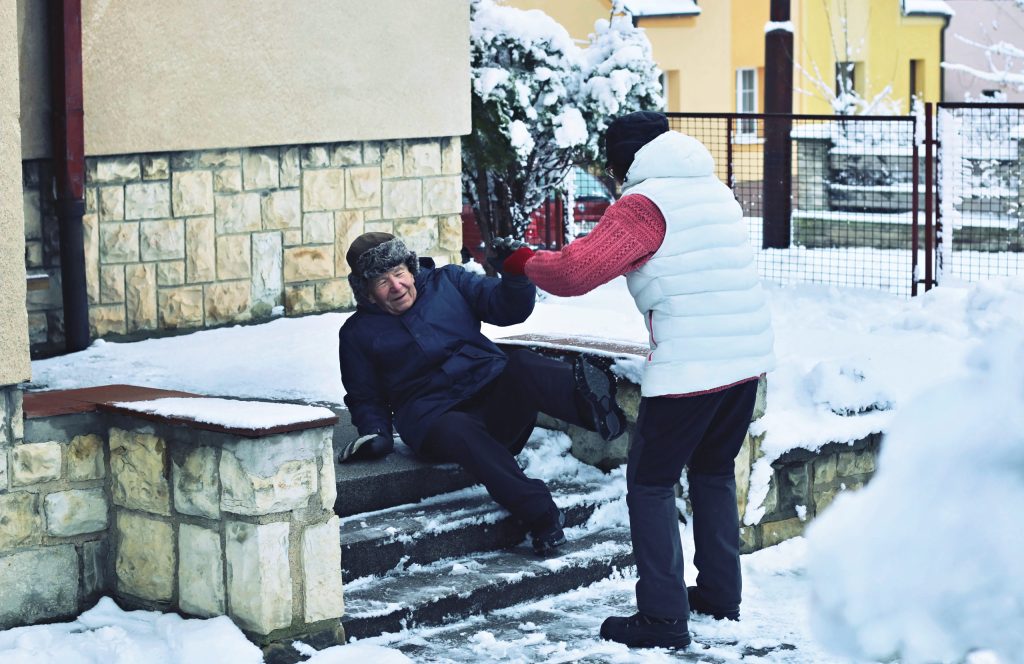As the temperature drops and winter sets in, the risk of falls among older adults significantly increases. Slippery sidewalks, reduced daylight, and indoor clutter all contribute to a spike in fall-related injuries. According to the Centers for Disease Control and Prevention (CDC), more than 3 million older Americans are treated in emergency departments annually for fall-related injuries, with over 800,000 requiring hospitalization. These statistics underscore the urgent need to prioritize fall prevention during colder months.

Common Causes of Falls During Winter
Slippery Surfaces and Ice Patches
Snow and ice accumulation on sidewalks, driveways, and parking lots create dangerous walking conditions. A hidden patch of ice near your vehicle or front steps can easily lead to a serious fall.
Poor Visibility and Foggy Glasses
During winter, shorter days mean less natural light, making it harder to spot obstacles. Additionally, facemasks—still common in flu season or during outbreaks—can cause eyeglasses to fog, reducing visibility.
Clutter Indoors from Staying Home More Often
With colder weather driving people indoors, homes can become more cluttered. Toys, rugs, and holiday decorations are all potential tripping hazards, especially for older adults helping care for grandchildren.
Proactive Steps for Preventing Falls in Cold Weather
Improve Home Safety
- Keep walkways clear of snow and ice. Use salt or sand to reduce slipperiness.
- Install handrails on stairways inside and outside.
- Use non-slip mats in bathrooms and kitchens.
- Keep hallways and rooms well-lit to improve visibility at night.
Wear Proper Footwear
Opt for shoes or boots with non-skid rubber or neoprene soles. Avoid slick leather soles or high heels, which offer little grip.
Stay on Top of Medical Checkups
Regular vision and hearing exams are crucial. Conditions like poor eyesight or impaired balance due to inner ear issues can greatly increase fall risk.
Addressing COVID-19 and Health Concerns During Winter
Virtual Healthcare Can Support Fall Prevention
Diana Curtis, RN, MSN, from Bayhealth, stresses that telemedicine remains a reliable option. Older adults can consult their healthcare providers for medication reviews and balance-related issues without stepping outside.
Keeping Masks Secure to Prevent Foggy Glasses
Curtis advises tightening the nose bridge area of your mask to prevent fogging. A clear line of sight is essential to prevent tripping or misjudging distances.
Avoiding Distracted Walking
Using a smartphone while walking or carrying too many items can throw off your balance. Always keep both hands free for stability.
Staying Active Safely Indoors and Outdoors
Indoor Exercises for Balance and Strength
Simple movements such as chair yoga, tai chi, or even stretches can enhance stability and muscle control.
Utilize Online Resources
Websites like the National Institute on Aging offer fall-prevention exercise videos and tips specifically designed for seniors.
Winter Travel and Parking Tips for Seniors
When heading out during winter:
- Check for ice patches around your parked vehicle.
- Take small, careful steps when walking on snowy or wet surfaces.
- Use a cane with an ice tip or a walker for added support.
Fall Prevention for Grandparents Providing Childcare
Older adults caring for young children should:
- Keep toys organized and off walking paths.
- Avoid walking while carrying children, especially in icy areas.
- Ensure indoor play areas are clear and well-lit.
Frequently Asked Questions
Q1: Why are falls more common in winter?
A: Falls increase during winter due to slippery outdoor surfaces, foggy glasses from cold air and masks, and more time spent indoors around potential clutter.
Q2: What shoes are best to prevent falls in winter?
A: Shoes with rubber or neoprene soles offer the best traction. Avoid smooth or high-heeled footwear.
Q3: How can seniors stay active indoors in winter?
A: Balance exercises like tai chi, gentle yoga, and guided online workouts from the National Institute on Aging are effective for maintaining strength.
Q4: Is telehealth helpful for fall prevention?
A: Yes, telehealth allows seniors to review medications, consult doctors, and assess balance concerns without leaving their homes.
Q5: What is a quick checklist for preventing falls during colder months?
A: Clear walkways, wear proper shoes, ensure home lighting, secure rugs, avoid distractions while walking, and keep both hands free for balance.




